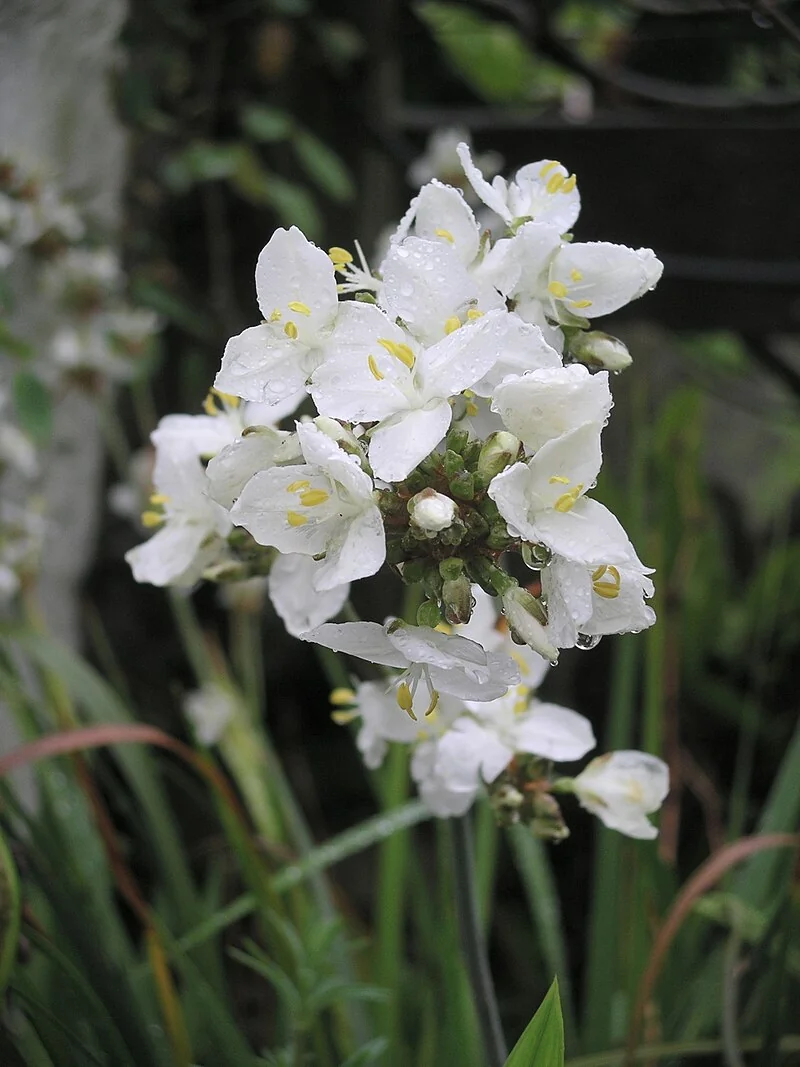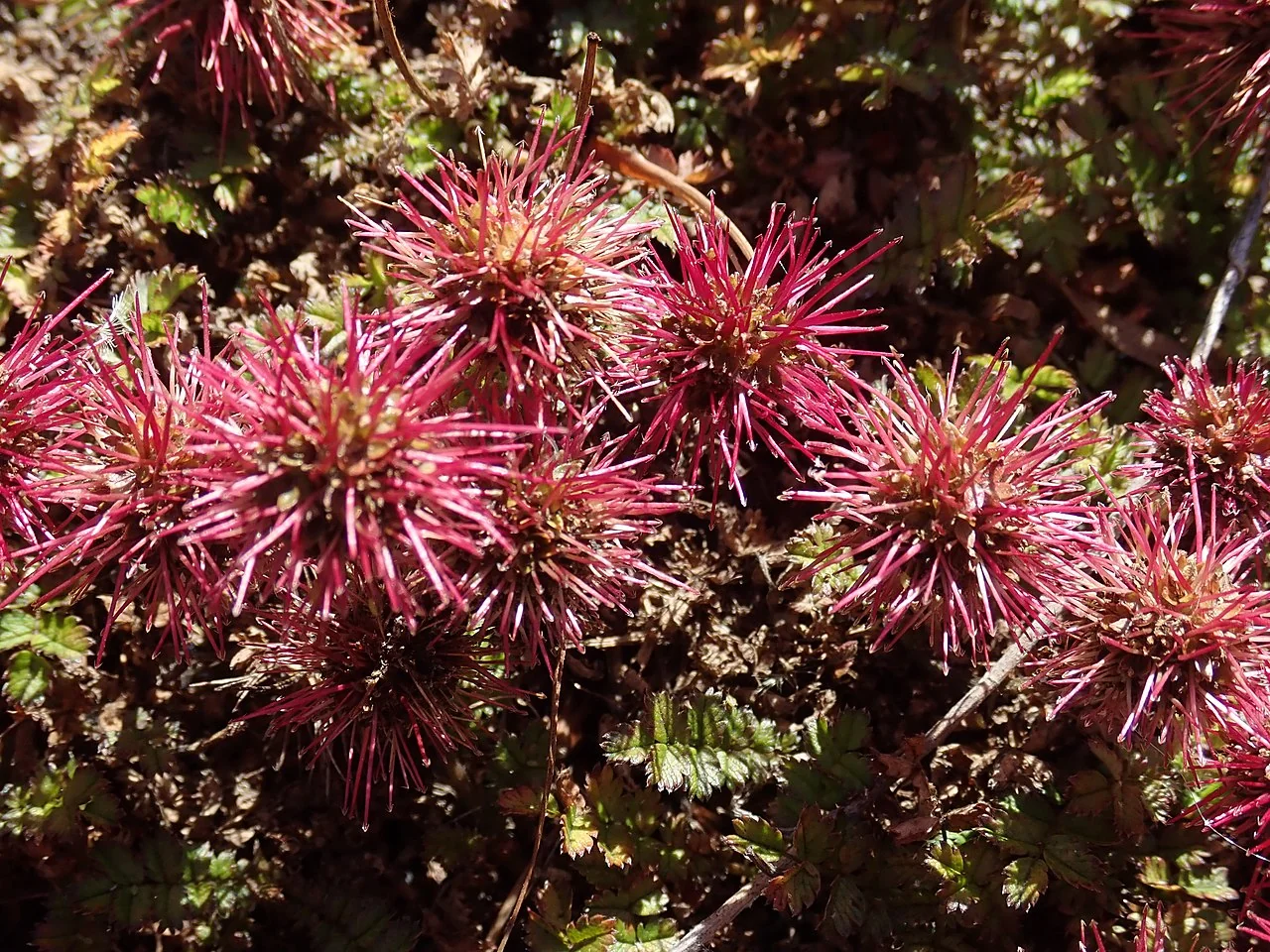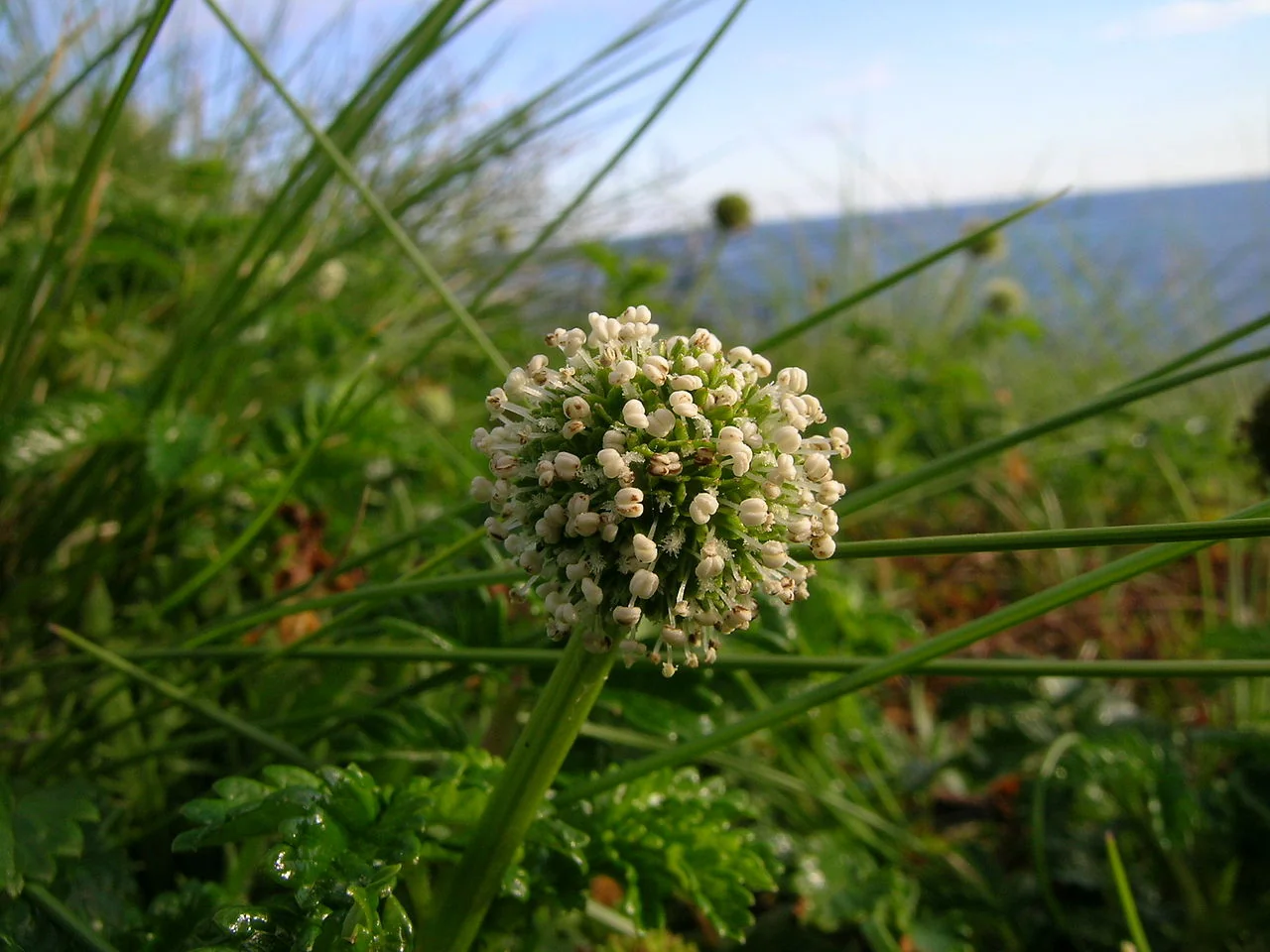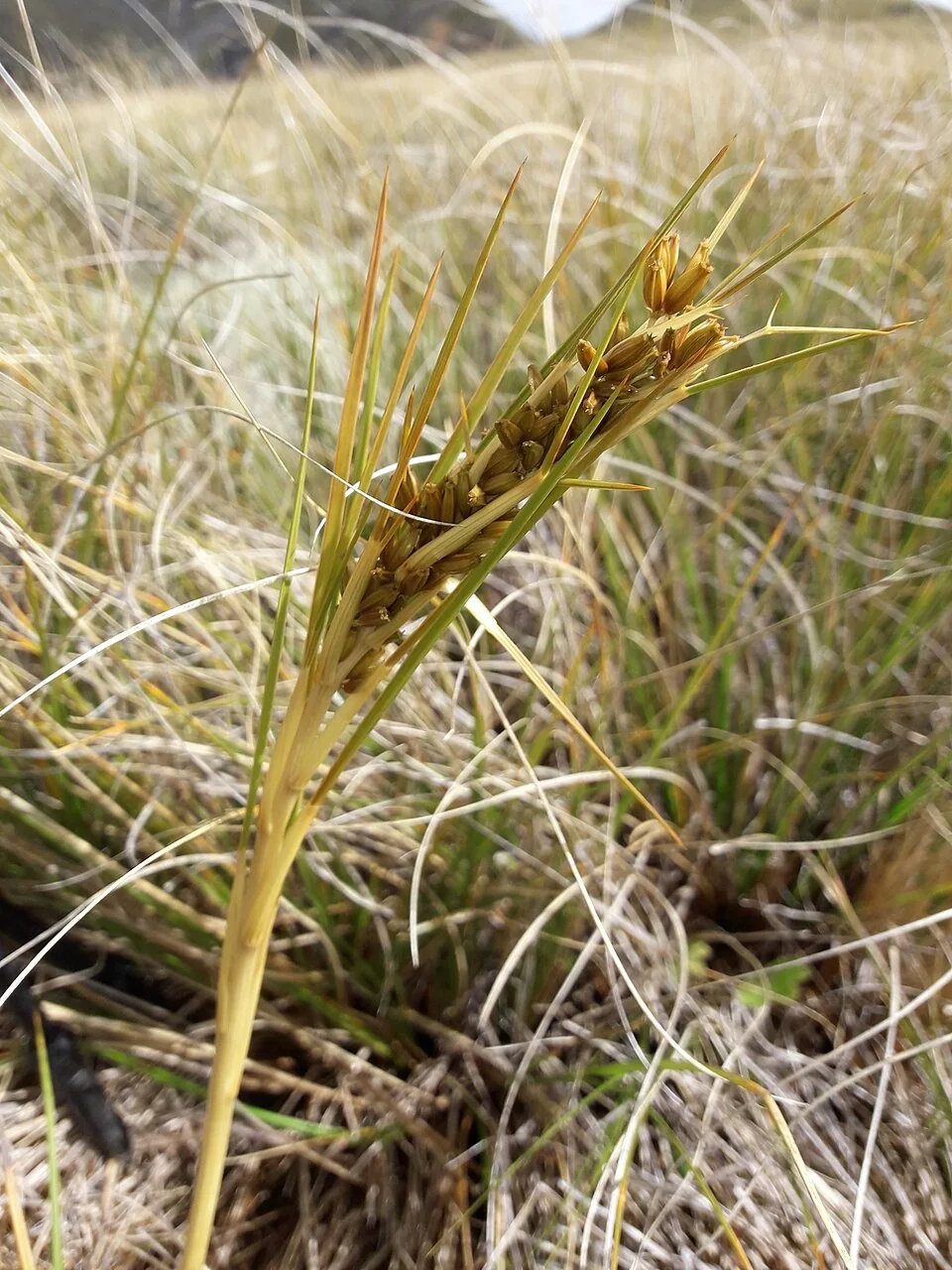
Large-Flowered NZ Iris
Libertia grandiflora
Libertia grandiflora , commonly known as the New Zealand Iris or Mīkoikoi, is a stunning evergreen perennial native to New Zealand's North Island. It forms large, symmetrical clumps of tough, dark green, grass-like leaves. In spring, it sends up tall, slender stems that bear clusters of pure white, three-petalled, iris-like flowers. These are followed by attractive orange-brown seed capsules that persist through winter, adding seasonal interest. Valued for its architectural form, it is a popular choice for a variety of garden designs, from modern courtyards to mixed borders. Explore more in the native plants index .

Plant Description
Botanical Features
Large-flowered NZ Iris is a distinctive native plant with unique botanical characteristics that make it well-suited to New Zealand's diverse environments . This species exhibits typical features of its genus and family, with specialized adaptations that allow it to thrive in its natural habitat. The plant 's morphological features, including its leaf structure, growth habit, and reproductive characteristics, reflect millions of years of evolution in New Zealand's isolated environment. Understanding the botanical description of Large-flowered NZ Iris helps gardeners appreciate its unique characteristics and provides insight into its cultivation requirements and ecological role.
Quick Facts
Quick Facts Overview
| Scientific Name | Libertia Grandiflora |
|---|---|
| Height | 0.5-0.9 meters |
| Spread | 0.6-1.0 meters |
| Water Needs | Moderate (adaptable to various conditions) |
| Light | Full sun to semi-shade |
| Frost Tolerance | Good (suitable for montane conditions) |
| Salt Tolerance | Moderate (grows near coastal areas) |
| Growth Rate | Moderate |
| Lifespan | Long-lived perennial |
Climate Best Suited to
Large-flowered New Zealand Iris is adapted to the temperate climate of the North Island, thriving from coastal to montane conditions. It performs well in areas with reliable moisture and good drainage, demonstrating excellent adaptability to diverse habitats.
Regional Suitability
| Whangārei | Ideal |
| Auckland | Ideal |
| Hamilton | Suitable |
| Rotorua | Suitable |
| Tauranga | Ideal |
| Gisborne | Ideal |
| New Plymouth | Ideal |
| Whanganui | Ideal |
| Palmerston North | Suitable |
| Napier | Ideal |
| Wellington | Ideal |
| Nelson | Ideal |
| Christchurch | Suitable |
| Dunedin | Suitable |
| Invercargill | Suitable |
| City | Climate Suitability |
|---|
Natural Habitat
Understanding the natural habitat of this plant provides essential guidance for successful cultivation and highlights the species' ecological requirements. The plant 's occurrence across diverse North Island environments , from coastal areas to montane locations, demonstrates remarkable habitat flexibility within specific environmental parameters.
Geographic Distribution
Libertia grandiflora is endemic to New Zealand's North Island, with a distribution extending from Te Paki in the far north to Wellington in the south, notably excluding the central Volcanic Plateau region . This distribution pattern suggests adaptation to coastal and hill country conditions rather than the pumice soils and extreme climate conditions of the central volcanic region. The species occurs from sea level to approximately 900 meters elevation, indicating broad climatic tolerance.
Habitat Types and Characteristics
Natural habitats share several key characteristics that inform cultivation requirements. Forest margins provide the transition zones between closed forest and open areas, offering moderate light levels and protection from extreme exposure. Steep slopes ensure excellent drainage while providing diverse microclimate conditions. Bluffs and cliff areas offer minimal competition and excellent drainage, though with increased exposure to wind and salt spray in coastal locations. Stream banks and river terraces provide seasonal moisture variation and periodic disturbance that maintains open conditions.
Substrate and Soil Conditions
Natural substrates range from rocky cliff faces to forest soils, but consistently provide excellent drainage. Soil fertility is generally moderate to low, reflecting the species' adaptation to nutrient-poor conditions. Many sites experience periodic disturbance from natural processes such as landslips, flooding, or wind damage, which maintains the open conditions required for establishment and continued growth.
Associated Flora
In natural habitats, it associates with a diverse range of native plants adapted to similar conditions. Common associates include various Carex species , native rushes, small native shrubs such as Coprosma species , and other forest margin herbs. These associations create complex plant communities that provide diverse habitat for native fauna while demonstrating successful plant combinations for restoration and naturalistic landscape applications.
Plant Conservation
Libertia grandiflora , also known as mīkoikoi or New Zealand iris, is a flowering plant species endemic to New Zealand. Its primary range is the North Island, where it is widespread from North Cape to Wellington, though it appears to be absent from the Volcanic Plateau. According to the 2023 assessment in the New Zealand Threat Classification System (NZTCS), Libertia grandiflora is classified as "Not Threatened." This conservation status has remained consistent since at least 2004. The plant is found in coastal to montane habitats, typically in open, lowland forest remnants, forest margins, on steep slopes, ridgelines, bluffs, cliffs, stream banks, and river terraces. It is easily propagated from fresh seed and by dividing established plants, and it can tolerate a wide range of conditions, excluding permanently waterlogged soils. It is also noted as an attractive plant that could benefit from wider cultivation.
Growing Requirements
Soil Requirements
Large-flowered New Zealand Iris adapts to various soil conditions:
- Well-draining soil preferred
- Tolerates wide range of soil types
- Thrives in both poor and moderately fertile soils
- Adapts to rocky sites, steep slopes, and forest soils
- Important to avoid permanently waterlogged conditions
Light Requirements
Very adaptable light conditions:
- Full sun to semi-shade
- Excellent for mass planting in various light conditions
- Tolerates open forest margins and woodland edges
- Performs well in coastal and montane exposures
Water Requirements
Moderate and adaptable water needs:
- Tolerates wide range of moisture conditions
- Regular watering beneficial during establishment
- Drought-tolerant once established
- Excellent for naturalistic gardens with varying moisture
- Important to avoid waterlogged conditions
Planting Guide
When to Plant
The best time to plant Large-flowered New Zealand Iris is during spring or early autumn when temperatures are moderate and rainfall is usually adequate for establishment.
Site Selection
Choose a site with:
- Full sun to semi-shade
- Well-draining soil
- Protection from waterlogging
- Space for mature clump size (1 m spread)
- Good air circulation
Planting Procedure
- Space plants 60cm-1 m apart for mass plantings
- Dig a hole twice the width of the root ball
- Ensure good drainage (add organic matter if needed)
- Position the plant at the same level it was growing
- Backfill with improved soil
- Water thoroughly after planting
- Apply organic mulch around the base
Initial Care
Water regularly during the first growing season to establish the root system. Once established , this hardy plant requires minimal care and tolerates a wide range of conditions.
Ecological Role
This plant plays important ecological roles within New Zealand's North Island ecosystems , serving as both a component species in forest margin communities and a contributor to broader ecosystem functions. Understanding these ecological relationships helps inform conservation and restoration efforts while highlighting the species' environmental value.
Habitat Creation and Modification
The dense clumping growth habit creates microhabitat conditions that support various smaller organisms, from soil invertebrates to epiphytic plants that may establish on the persistent leaf bases. The extensive rhizome systems contribute to soil stabilization, particularly important on the steep slopes, ridgelines, and cliff areas where the species naturally occurs. This soil -binding function helps prevent erosion in vulnerable coastal and montane environments.
Wildlife Relationships
The white flowers provide nectar resources for native pollinators, including various fly and bee species active during the September- November flowering period. The bright orange seeds may serve as food sources for native birds, though specific seed predation relationships require further research. The persistent winter seed pods provide resources during periods when other food sources may be limited.
Community Dynamics
In natural forest margin communities, it often associates with other native plants adapted to open, well-drained conditions. These associations include various native sedges, small shrubs, and other herbaceous species that collectively create diverse plant communities. The species can serve as a pioneer plant on disturbed sites, helping to stabilize soils and create conditions suitable for other native plants.
Ecosystem Services
Beyond direct wildlife support, L. grandiflora contributes to ecosystem services including carbon sequestration through its perennial growth habit and extensive root systems. The species ' tolerance for marginal sites makes it valuable for restoration of degraded areas, particularly those transitional zones between forest and open habitats that are often difficult to revegetate successfully.
Uses Section
Uses Section Overview
This versatile native plant offers multiple practical applications in landscaping and garden design, from providing ground cover and erosion control to creating habitat for native wildlife. The plant 's natural characteristics make it valuable for restoration projects and sustainable gardening practices.
Cultural Significance
Traditional Uses and Values
Libertia grandiflora , commonly known as mīkoikoi or New Zealand iris, holds cultural significance primarily within Māori culture in New Zealand.
In Māori tradition, Libertia grandiflora is revered as a symbol of growth and rejuvenation. It frequently appears as a motif in traditional Māori art and literature, representing new beginnings and the inherent beauty of nature. This artistic representation highlights the profound connection the Māori people have with their natural surroundings.
While not extensively used in traditional medicine or crafts, Libertia species, including L. grandiflora, are valued as part of New Zealand's natural heritage. They are increasingly being incorporated into contemporary marae gardens and eco-restoration projects, signifying their ongoing importance in cultural restoration practices and their role within mātauranga Māori (Māori knowledge systems) for sustaining healthy forests and local ecosystems.
Landscaping Applications
Large-flowered New Zealand Iris offers exceptional versatility in landscape design, combining bold architectural foliage with spectacular seasonal flowering displays and winter interest from persistent seed pods. Its adaptability to diverse conditions and low maintenance requirements make it valuable for both residential and commercial landscape projects.
Mass Planting Applications
The species excels in large-scale mass plantings where its bold foliage texture can create dramatic landscape statements. Plant in drifts or blocks using 80cm-1.2 m spacing to achieve effective groundcover while allowing individual clumps to develop their natural form. Mass plantings are particularly effective on slopes, embankments, and areas where low-maintenance groundcover is desired. The consistent foliage colour and form create visual unity across large areas.
Architectural and Specimen Use
Individual specimens or small groups provide strong architectural elements in mixed borders and foundation plantings. The broad , leathery leaves offer textural contrast to fine-leaved plants and create focal points in designed landscapes. Position near pathways or seating areas to showcase the distinctive foliage and seasonal flower displays. The plant 's substantial size makes it suitable for creating privacy screens or informal hedging in appropriate locations.
Naturalistic Landscape Design
Libertia grandiflora is ideal for naturalistic landscape approaches that seek to replicate native plant communities. Combine with other forest margin species such as native sedges, Astelia species , and appropriate native shrubs to create authentic New Zealand plant associations. This approach is particularly effective in restoration projects or landscapes seeking to reflect regional botanical character.
Commercial and Public Landscape Use
The species ' low maintenance requirements and adaptability make it excellent for commercial landscapes, public spaces, and urban environments. Its tolerance for atmospheric pollution and variable growing conditions suits contemporary landscape challenges. Use in corporate landscapes, parks, streetscapes, and institutional settings where reliable performance and minimal maintenance are priorities. The extended seasonal interest from flowers and seed pods provides year-round landscape value.
Seasonal Care Calendar
Spring
- Peak flowering season with spectacular white iris-like flowers
- New growth emerges with fresh yellowish-green foliage
- Best time for planting and establishment
- Remove any winter-damaged leaves
Summer
- Continued flowering through to November
- Peak growth period with lush foliage development
- Begin seed pod development
- Regular watering beneficial in dry conditions
Autumn
- Decorative golden seed pods develop
- Bright orange seeds mature (December-April)
- Natural seed dispersal begins
- Good time for seed collection
Winter
- Evergreen foliage provides year-round structure
- Golden seed pods persist as attractive winter interest
- Good frost tolerance in montane conditions
- Minimal maintenance requirements
When to Prune and How Much
When to Prune and How Much Overview
Large-flowered New Zealand Iris requires minimal maintenance:
- Remove spent flower stems after blooming if desired
- Cut back old or damaged leaves at any time
- Leave seed pods for decorative winter interest
- Generally best left unpruned to maintain natural clump form
- Division every 3-4 years can rejuvenate large clumps
The broad , leathery foliage and persistent seed pods are major attractions, so minimal pruning maintains the best ornamental effect.
How to Grow Large-Flowered NZ Iris
Large-flowered New Zealand Iris, also known as Mīkoikoi or Tukauki, is the most impressive of New Zealand's native iris species. It forms robust clumps of broad, leathery, flax-like leaves and produces magnificent spikes of large, pure white iris-like flowers. This North Island endemic is an outstanding architectural plant for mass plantings in sun or semi-shade, bringing both dramatic foliage texture and spectacular seasonal flowering displays to New Zealand gardens. Understanding its propagation methods is key to successfully growing this beautiful species.
From Seed
Propagating Large-flowered NZ Iris from fresh seed is a very effective method. Collect the bright orange seeds from the decorative golden capsules when they are ripe, typically between December and April. Sow fresh seed immediately for best germination rates in a well-draining seed-raising mix. Keep the mix consistently moist during germination. Germination usually occurs within a few weeks to months. Once seedlings are large enough to handle, typically when they have developed a few true leaves, they can be transplanted into individual pots and grown in a sheltered location before planting out. Flowering typically occurs in the second or third year after sowing.
From Division
Division of established clumps is a straightforward and reliable method for propagating Large-flowered NZ Iris. This is best done in spring or early autumn. Carefully lift entire clumps to preserve the root systems. Split the clump into smaller sections, ensuring each section has a healthy portion of roots and shoots. Replant the divisions immediately into well-prepared soil that is well-draining and fertile. Water thoroughly after planting and maintain consistent moisture until established. Plants typically re-establish within one season and will flower the following year.
Pests and Diseases
Generally Hardy
- Natural Resilience: Very tough and resistant to most problems
- Wide Adaptability: Thrives in diverse conditions with few issues
- Low Maintenance: Rarely requires pest or disease management
Potential Issues
- Crown Rot: Can occur in poorly-drained or waterlogged soils
- Snail Damage: Young shoots may be damaged by snails and slugs
- Aphids: Occasionally affected by aphids on new growth or flower stems
Environmental Sensitivities
- Waterlogging: Most sensitive to permanently wet or poorly-drained soils
- Competition: May struggle when overwhelmed by aggressive weeds
- Extreme Conditions: May show stress in very exposed or harsh sites
Management
Ensure good drainage and adequate spacing. Remove competing vegetation during establishment. This naturally hardy plant rarely requires intervention when grown in suitable conditions.
Bonus Tip
Honoring a Pioneer Botanist
The genus Libertia was named in honour of Marie-Anne Libert (1782-1865), a pioneering Belgian botanist. She was one of the first women to be recognized for her scientific contributions, particularly in the study of plant diseases. This naming is a tribute to her significant work and legacy in the field of botany.







